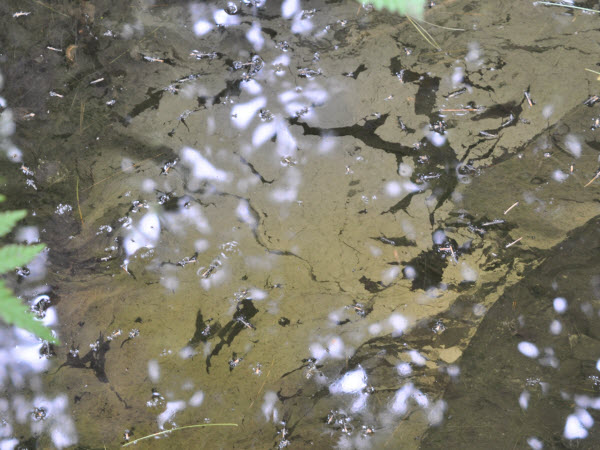Iron Bacteria
Hiking in the woods, I occasionally come across a shiny film - very like oil - on water in wetlands and streams. In most areas I discount pollution of a petroleum product, and assume a biological origin. But how to know? And how is this film biological?
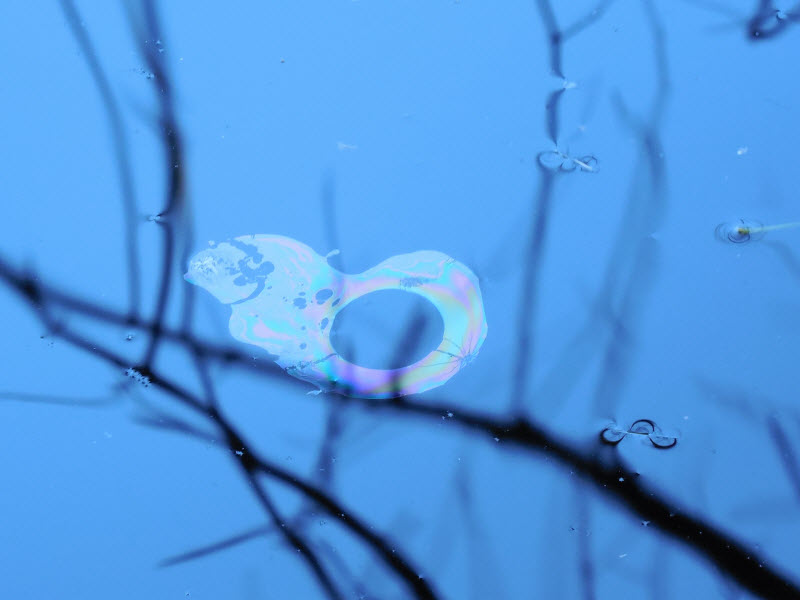
Recently I did an Internet search, and found a posting, "Oil spill on my pond?. Quoting from the article,
this may not be oil. Poke the film - "if it immediately “heals” – that is the shiny film closes back up again - it really IS oil. If it doesn’t, it’s a naturally occurring bacteria or other natural source. According to the USGS, these kinds of films ”can be found anywhere that ground water, which lacks oxygen and carries iron and manganese, discharges into a stream.” I assume ponds are likely candidates, too."
The image above brings these points out. My first assumption with this was that it most likely was an oily film - whether petroleum or biological. But on thinking about the remarks of "winterwoman", I realize that this is certainly not an oily film, as indeed it has not closed up to form a continuous sheen, but instead shows many breaks, and no disposition to heal.
In another location I found this example, even more clearly not an oily substance.
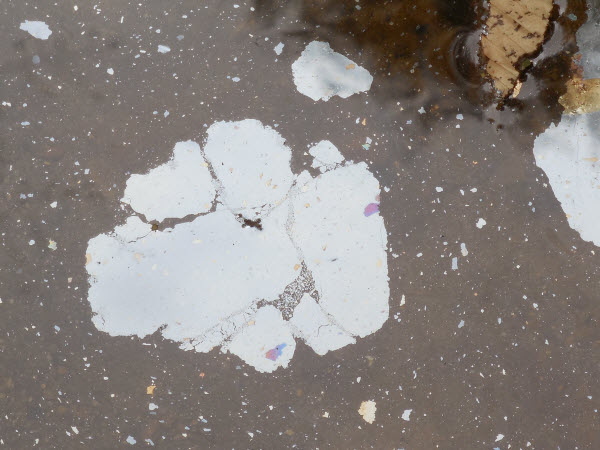
The posting by "winterwoman" continues on to quote a USGS article:
"certain bacteria, the oxidizers, fix oxygen onto iron and manganese. Other bacteria, the reducers, remove the oxygen. In fixing or removing ioxygen, some are getting energy and others are performing other life functions. Bacteria have been involved in the iron and manganese cycles for billions of years."
I followed the references in the winterwoman posting, but now knew to key on iron bacteria. I found soemone's thesis that had some interesting and detailed information (did not record the reference), but did not help me understand the whole picture. In time I came to a wikipedia article, Iron Bacteria. The article names two bacteria, Thiobacillus ferrooxidans and Leptospirillum ferroxidans, and says "Iron Bacteria are bacteria that derive the energy they need to live and multiply by oxidizing dissolved ferrous iron (or manganese). The resulting ferric oxide is insoluble, and appears as brown gelatinous slime that will stain plumbing, clothing, etc"
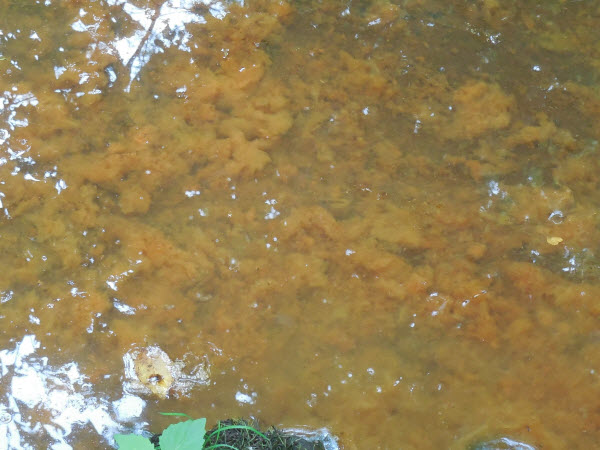
Some time later I found a stream that might have just been muddy. But, the more I looked at it, the more I wondered if this was really the insoluble ferric oxide, "brown gelatinous slime". And so I explored the stream further, and found some outstanding areas of the oil like sheen, fractured.

The underlying chemistry is interesting. Summarizing directly from the quoted wikipedia article:
- Microbial populations in de-oxygenated water with specialized enzymes can reduce insoluble ferric oxide in aquifer soils to soluble ferrous hydroxide. The bacteria use the oxygen released by this process.
H20 + Fe2O3 ⇒ 2Fe(OH)2 + O2 - When de-oxygenated water reaches a source of oxygen, iron bacteria use that oxygen to convert the soluble ferrous iron back to an insoluble reddish precipitate of ferric iron:
2Fe(OH)2 + O2 ⇒ H2O + Fe2O3 - The first reaction requires biological coupling with a simultaneous oxidation of organic material (carbon) dissolved in water, and so is often found where there is decaying vegetation such as in swamps.
- A similar reaction occurs with manganese dioxide
- Iron bacteria produce unpleasant tastes and odors, may produce a rainbow colored oil-like sheen on the water, produce a sticky slime that is typically rusty in color, and produce a feathery or filamentous growth
All of this seems a good fit for what I have seen, and my photographs, here.
I realize that I still am not clear, however, what that oily sheen really is! Does that sheen contain the bacteria? I presume it is high in mineral content - that is why it fractures rather than healing and acting oil-like. What is the molecule? is it simply the insoluble ferrous oxide? In fact, the same molecule that also forms the brown gelatinous slime that is presumably the content of the photo two up? Or something else?
I found a little more in these two links. First, http://www.michigan.gov/documents/deq/deq-oea-nop-bacteria_378414_7.pdf. This is a brief description, with this: "Bacteria create oil-like films when they attach themselves to the water surface", and http://pubs.usgs.gov/of/1996/0081/report.pdf: "The oil slicks are formed by Leptoghrix discophora. This colorless rod-shaped bacterium has a holdfast which attaches to the air-water interface. It then proceeds to secrete extracellular proteins and carbohydrates. The refraction of light off the holdfasts and secretions look like an oil slick.
So - seems the "slick" does contain the bodies of the bacteria, And I guess the physical properties come largely from the secretions. Seems these would be high and mineral content, but what is said in last quote is that the secretion is protein and carbohydrate. So I think I don't yet have the full story!
The images above were all from eastern Massachusetts. Hiking in Indiana I have found similar iron bacteria films. A stream in Turkey Run State Park clearly runs through areas of high iron content, and also meets the criteria of an area with high organic material that exceed the conentration of disolved oxygen, leading to anaerobic conditions (taken from the wikipedia article referenced above).
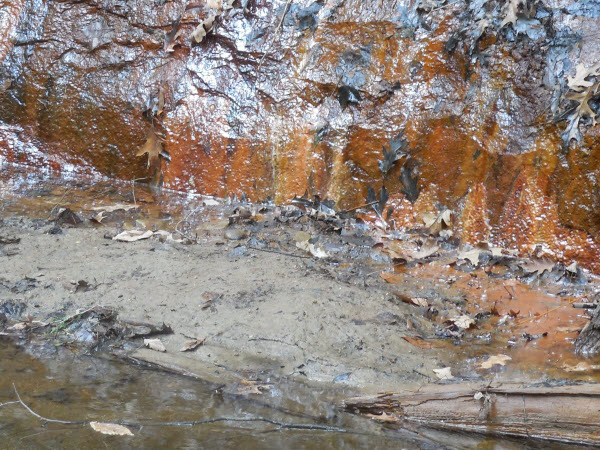
Downstream from this area:
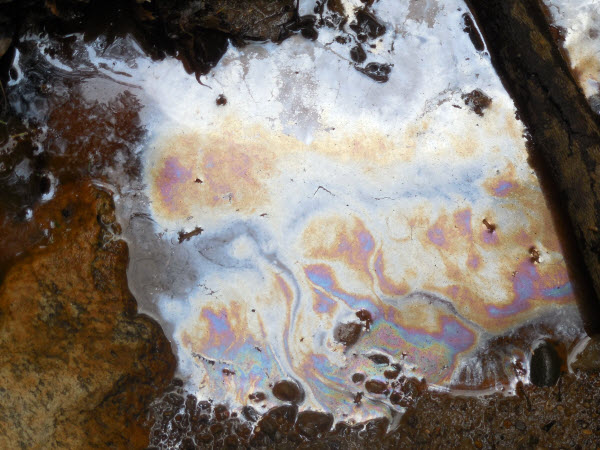
It is interesting how many places I now see the iron bacteria films. Of course I continue to take pictures as I see interesting spots!
